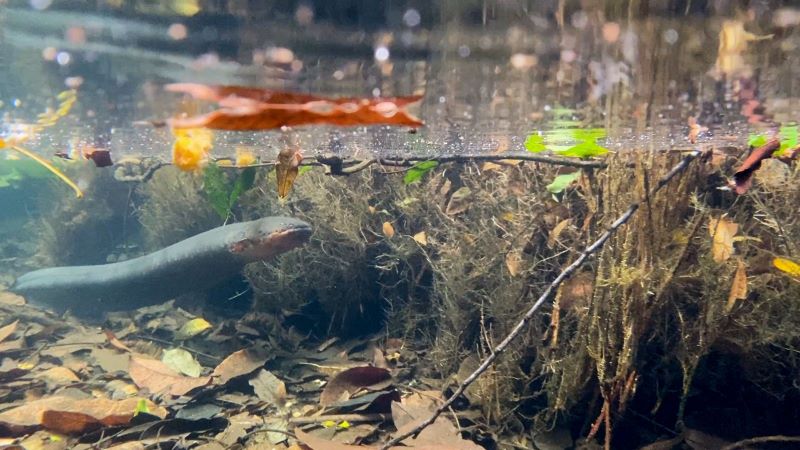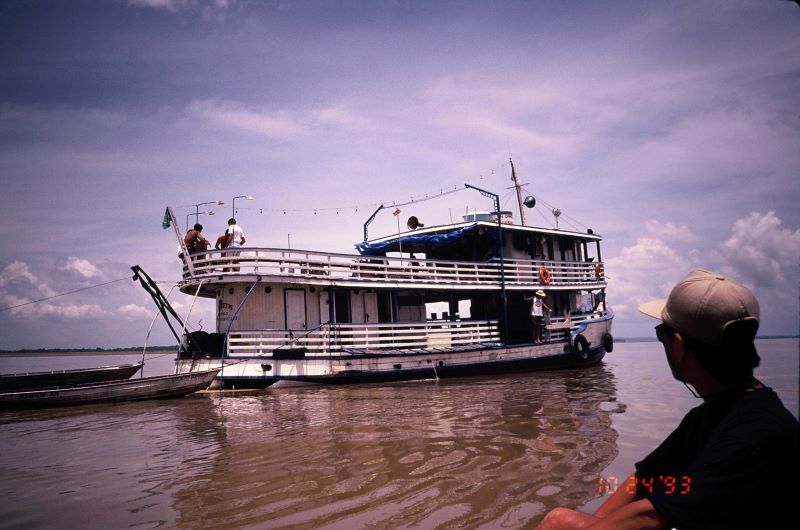


The best-known electric fish are poraquês, which can emit electrical discharges of up to 860 volts, depending on the species (photo: Phelipe Janning/Agência FAPESP)
Published on 06/05/2024
By André Julião | Agência FAPESP – Poraquês (Electrophorus spp.) are the best-known electric fish, partly because of their size (up to 2.5 meters long), but mainly because of their ability to emit electrical discharges of up to 860 volts. The shock is capable of paralyzing prey and even affecting humans for a few seconds.
However, most of the 250 or so species in their order, the Gymnotiformes, are elongated little fish with small eyes that live in rivers, lakes and streams and emit weak electrical signals, enough to communicate and navigate. One species with these characteristics, for example, is Iracema caiana, which was collected only once in 1968 and has never been found again.
Between February 20 and March 2, a group of scientists scoured the bottom of the Negro River – in the state of Amazonas, Brazil – streams and other environments in the region in search of little-known Gymnotiformes, such as Iracema caiana, as well as specimens that could support ongoing studies and even lead to the description of new species.
On board the vessel Comandante Gomes, around 20 people, including crew, researchers and a team from Agência FAPESP, traveled upriver from Manaus, the capital of the state of Amazonas, to Santa Isabel do Rio Negro, passing through conservation units and other municipalities in the state. The description of the details of the fieldwork is part of a new edition of the Field Diary series.

Researchers spent two weeks on a boat similar to the one used in a series of expeditions carried out in the 1990s as part of the Calhamazon project (photo: researcher’s archive)
During the two-week trip, the team followed a path similar to that of Alfred Russel Wallace (1823-1913) in 1850, when the naturalist – coauthor of the theory of evolution – documented some of the Amazon’s fauna and flora.
The expedition is part of the project “Diversity and Evolution of Gymnotiformes”, supported by FAPESP and coordinated by Naercio Menezes, professor at the Museum of Zoology of the University of São Paulo (MZ-USP).
“In the almost seven years that the project has been underway, we’ve made a number of discoveries and collected a large number of specimens for our collection, which, as a result of ongoing and future research, will continue to produce innovative results for some years to come. After the great drought that recently affected the Amazon region, we hope to find the fish concentrated in smaller aquatic environments, which should make collecting and studying them easier,” Menezes explained on the eve of the expedition.
One of the best-known results of the project was the discovery and description in 2019 of two new species of poraquê, previously thought to be one. The discovery had international repercussions, as the largest electrical discharge ever recorded in an animal, 860 volts, was found (read more at: agencia.fapesp.br/31386/).
The researchers also revealed the feeding habits of one species in the genus (read more at: agencia.fapesp.br/36946/) and the social predatory behavior of another, which is very rare in fish and other vertebrates (read more in the research article published in the journal Ecology and Evolution).
During the project, a technique was also used to identify the fish present in a given aquatic environment using only samples of body fragments (scales, skin, feces, etc.) present in the water, called environmental DNA sequencing. MZ-USP became the first Brazilian institution to have this type of sample deposited in its collection (read more at: agencia.fapesp.br/37382/).
Genetic wealth
More than knowing and cataloging the orders, families, genera and species of animals, today’s zoological studies are delving into the genetic differences within the various populations that make up the same species.
“Therefore, conservation doesn’t necessarily have to be linked to the species, because if there’s a genetic wealth distributed among different populations of one of them, it should also be recognized and protected,” explains Murilo Nogueira de Lima Pastana, curator of the fish collection and professor at MZ-USP.
For this reason, one of the goals of the trip was to collect small muscle or fin samples whose genomes could be sequenced, even from species already in zoological collections. Once the specimens are preserved in formaldehyde, their DNA is degraded and difficult to reconstruct in its entirety using today’s techniques.
However, even this challenge could soon be overcome, thanks to the acquisition by MZ-USP, with support from FAPESP, of a set of equipment that will allow so-called historical DNA to be sequenced.
Mysterious fish
The expedition was imbued with the great expectation of collecting new specimens and genetic material of Iracema caiana, the mysterious electric fish collected by the researcher Tyson Roberts in 1968 and described by Mauro Luís Triques in 1996, with the support of FAPESP.
Currently, the only four known specimens of the species are deposited at MZ-USP. Not even large expeditionary projects in the Amazon, such as Calhamazon, which collected more than 20,000 specimens of 510 species in the 1990s, have managed to find new specimens of Iracema caiana.
“There was little precision in the geographical determination of the collection site at the time the specimens were collected, due to the lack of precise georeferencing devices, such as GPS, commonly used in modern scientific expeditions. Using geoprocessing tools, we estimated an area where Tyson Roberts probably collected Iracema caiana, based on his description of the sampling site, in what is now the Baixo Rio Branco-Jauaperi Extractive Reserve,” explains Raimundo Nonato Mendes Gomes Júnior, an environmental analyst at the Chico Mendes Institute for Biodiversity Conservation (ICMBio), affiliated with the Brazilian Ministry of the Environment and Climate Change, and a doctoral student at MZ-USP.
The expedition will also be an opportunity for master’s and doctoral students to be trained in fish collection and storage techniques and to be exposed to the Amazon, a region with the greatest diversity of fish in the world, many of which have yet to be named and formally described.
The work also strengthens ties with project partners such as the National Institute for Amazonian Research (INPA), the Federal University of Amazonas (UFAM) and the Federal University of Bahia (UFBA) in Brazil, and the Smithsonian Institution's National Museum of Natural History (NMNH) in the United States.
Source: https://agencia.fapesp.br/51870